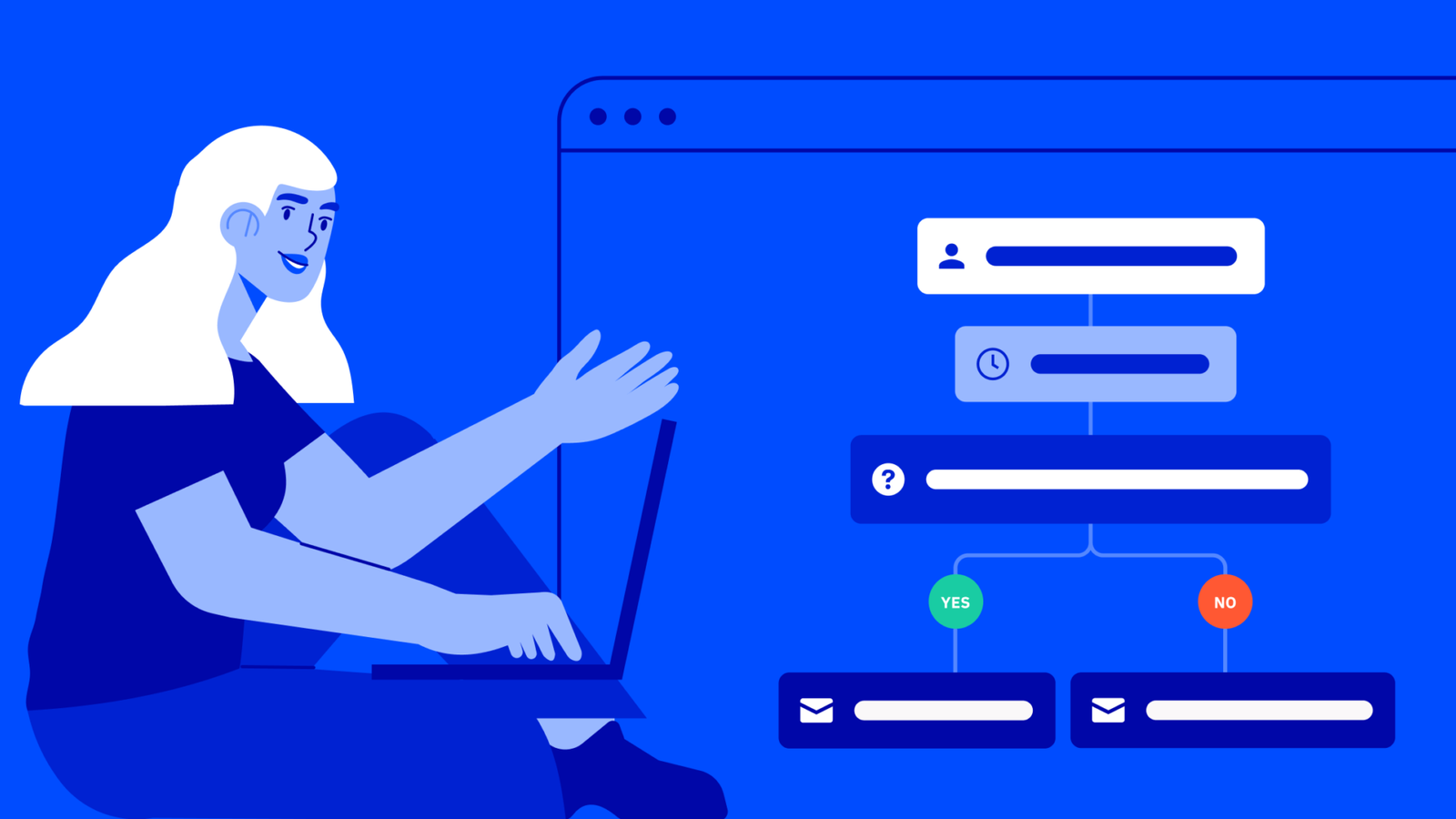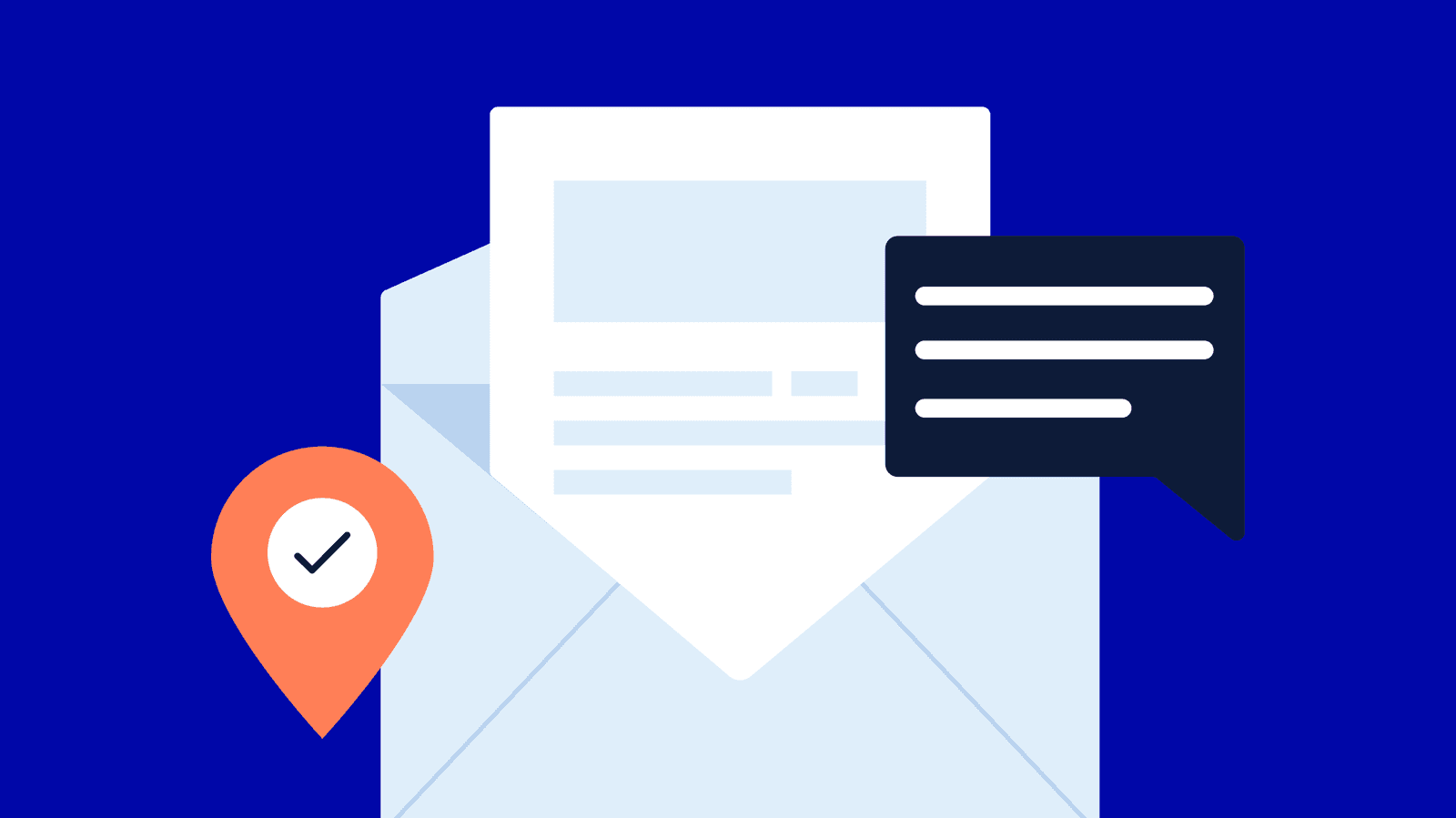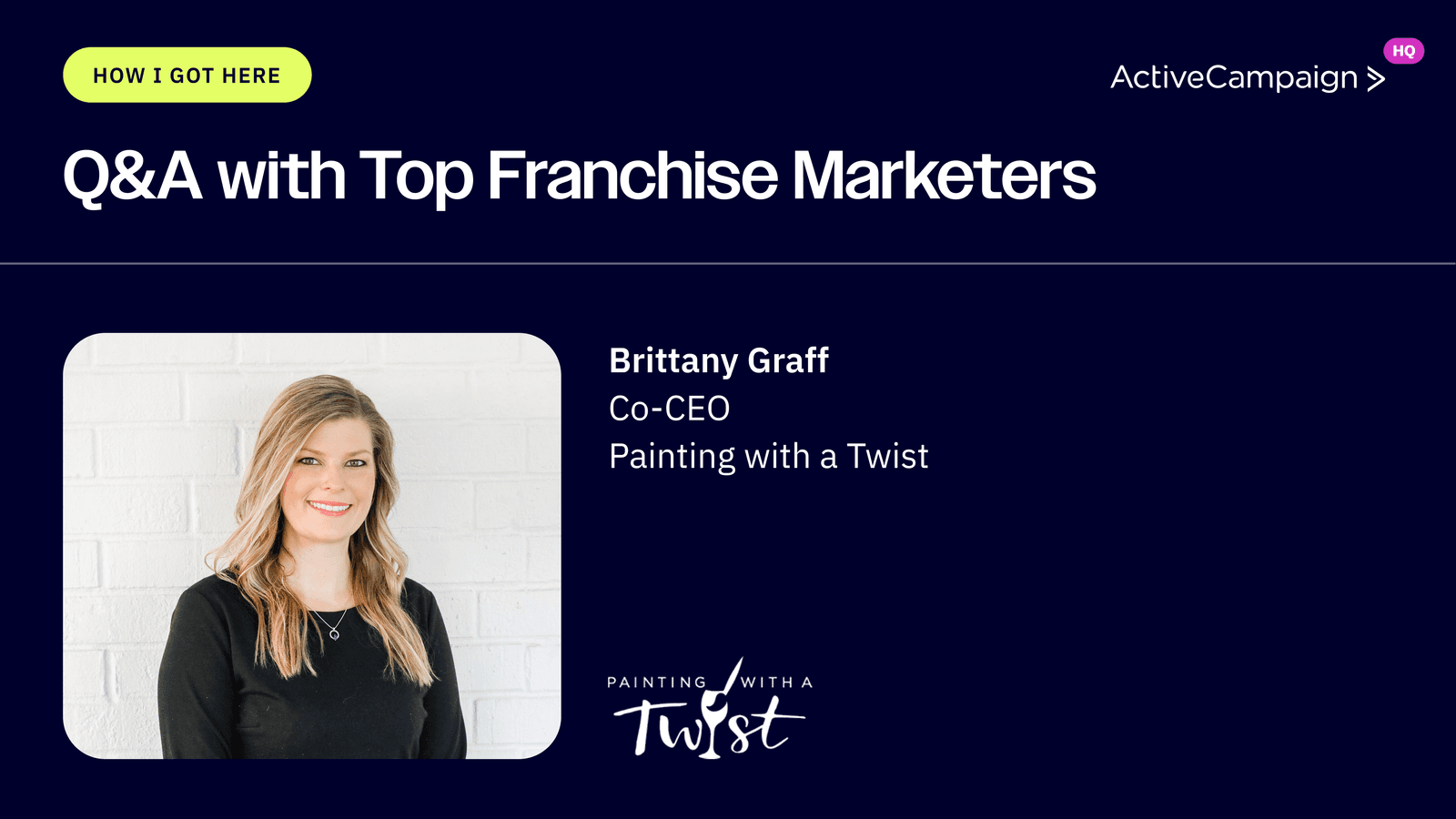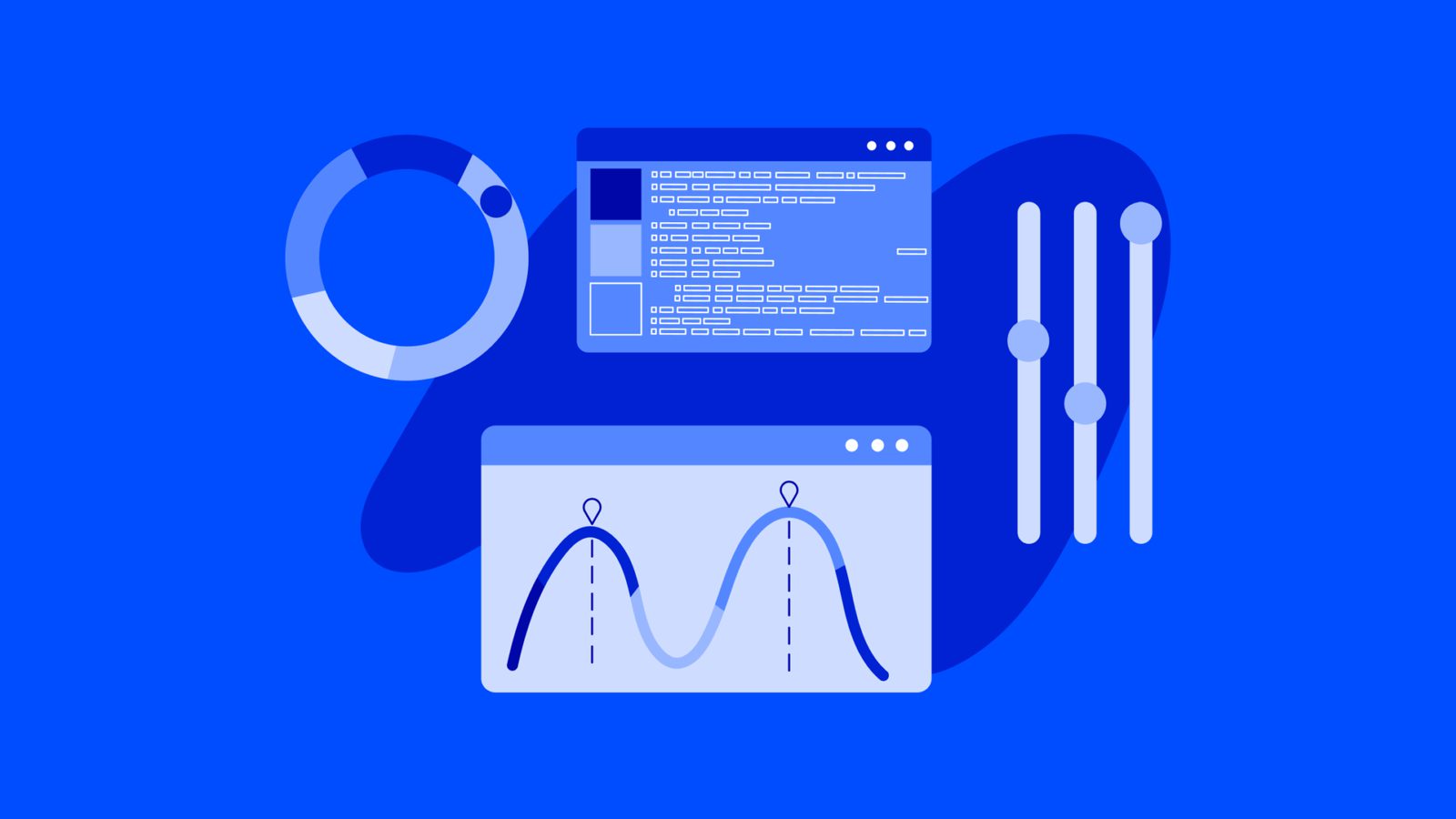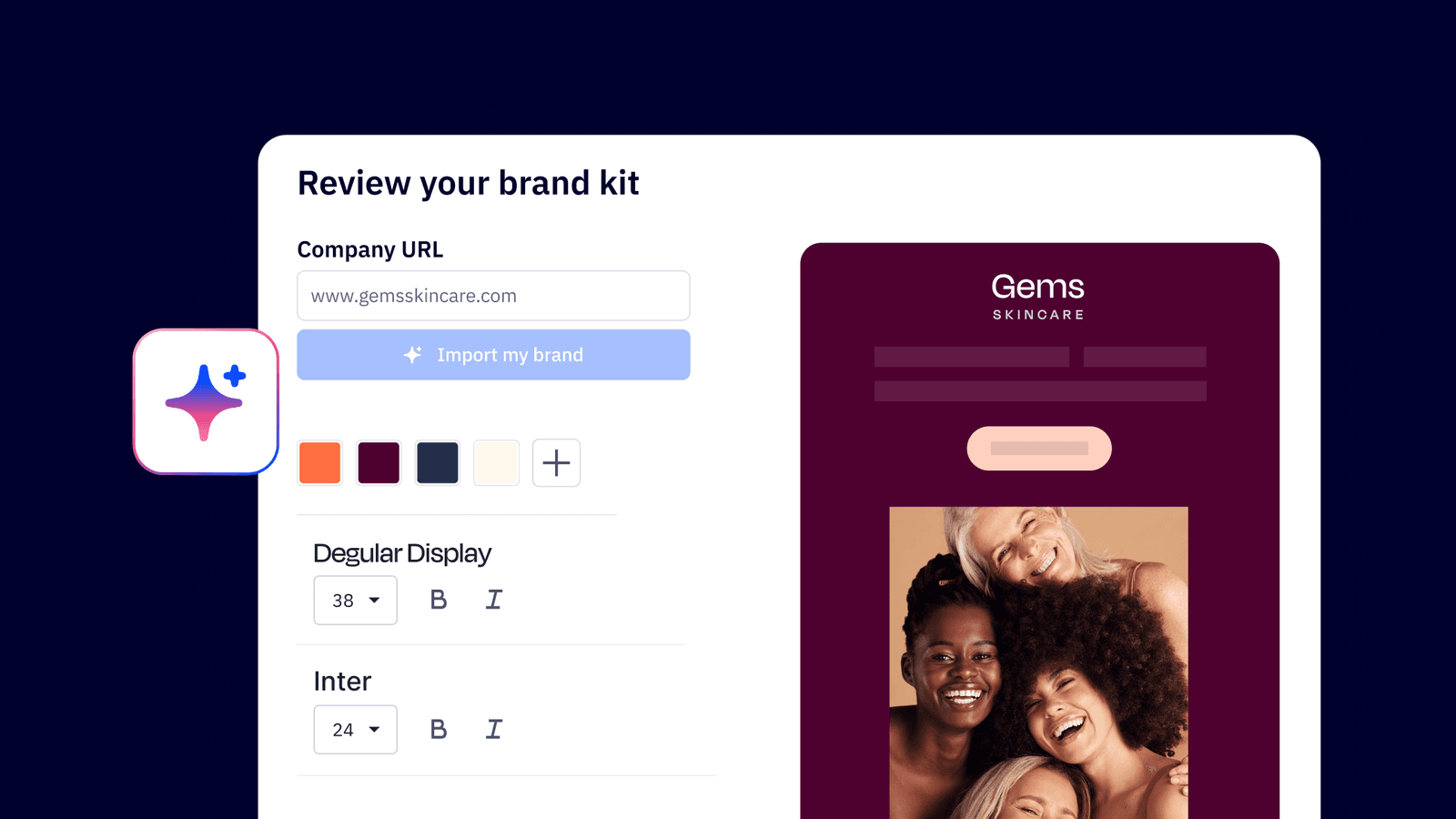Feeling like your marketing campaigns aren’t hitting the mark? Struggling to stand out from competitors or convert visitors before they bounce? Customer segmentation might be the missing piece.
By dividing your audience into meaningful groups, you can personalize messaging, improve customer experiences, and uncover new opportunities for growth. Done right, segmentation turns broad marketing efforts into highly targeted, high-performing strategies.
In this article, we’ll break down the definition of customer segmentation, why it’s more important than ever, emerging trends you should know, and how to put segmentation to work for your business.
What is customer segmentation?
Customer segmentation is the process of dividing your customers into groups based on shared characteristics, such as demographics, behavior, or purchasing patterns, so that you can deliver more targeted and effective marketing.
Instead of treating your audience as one massive group, segmentation helps you personalize communication, streamline campaigns, and create products or services that feel tailor-made for each group.
Marketers commonly use customer segmentation for email marketing, ad targeting, and customer journeys. But its impact goes even further, helping product development teams design better solutions and customer service teams deliver faster, more relevant support.
Did you know? The results of customer segmentation speak for themselves: In 2024, 63% of marketers said personalization enhances customer interactions and led to an increased revenue of 40%.

Bottom line? Customer segmentation creates a win-win: customers get better experiences, and businesses drive stronger results.
Customer vs. market segmentation
Customer segmentation and market segmentation sound similar, but they serve slightly different purposes.
Customer segmentation focuses on dividing your existing or potential customers into specific groups based on shared characteristics, such as behavior, demographics, or needs. It’s about understanding who is already interacting with your brand, or who could be, and how you can better serve them.
Market segmentation takes a broader view. It focuses on slicing up the entire potential market into segments, whether they are your customers or not. It's often used for positioning products, identifying new market opportunities, or determining where to focus expansion efforts.
Did you know? While customer segmentation is tactical (how to better serve the people you're already reaching), market segmentation tends to be more strategic (where to expand and why).
Both are important, but for day-to-day marketing, customer segmentation usually has the bigger immediate impact. It helps you craft campaigns that speak directly to your audience’s current wants and needs, boosting engagement, loyalty, and conversions.
What is customer segmentation analysis?
Customer segmentation analysis is the process of reviewing and interpreting your customer segments to better understand behaviors, patterns, and opportunities. It’s not just about putting people into buckets—it’s about digging deeper into the "why" behind their actions.
Through segmentation analysis, you can:
- Identify high-value customer groups that drive the most revenue.
- Spot underserved segments with growth potential.
- Customize offers, messaging, and experiences for each segment.
- Allocate resources more effectively by focusing on what’s working.
Example: After running a customer segmentation analysis, you find that a small group of customers who engage primarily via SMS have a much higher conversion rate than your email-only list. That insight could help you prioritize SMS campaigns, boost ROI, and personalize outreach even further.
When done right, customer segmentation analysis doesn’t just validate your assumptions, it challenges them and reveals new ways to grow your business.
5 types of customer segmentation models (with examples)
When you segment customers, you can do so according to any criteria you like. You can customize your segments to your business needs and goals.
Thinking about your customers in segments can spark new ideas and inspire your next marketing campaign or product line. You'll be able to identify what's truly unique about your customer base and tailor your entire business to serving those niches.

Although you can choose your customer segments, there are five main ways to segment customers that can help jumpstart your strategy.
1. Demographic segmentation
Demographic segmentation categorizes customers by observable traits, such as age, gender, marital status, or occupation. It's one of the most common ways to segment customers because demographic data is often easier to collect than other types of data.
With broad groupings, you can create high-level strategies for large swaths of your target audience. For instance, if you have product lines at different price points or geared toward different genders or age groups, you can create an overall strategy for each segment that highlights the best products for them.
Personalization helps people to feel they’re being heard… I can reference their bass guitar model when talking about pain points.
Here are a few examples of how you can use demographic segmentation in your strategy.
You can segment your audience by:
- Income to highlight products based on price point
- Age to decide which social media platforms are most appropriate to reach potential customers
- Family size to offer deals and packages for larger groups
2. Geographic segmentation
Geographic segmentation is pretty simple. You need to gather your customers' location data. Once you have that data, you'll need to consider how specific your geographic data should be. Do you need to know a customer’s zip code or address, or will just their country or region be enough?
Here are a few ways to use location data to segment customers:
- By country or region to provide the correct language or currency
- By zip code to run ads for local stores or deals
- By urban, suburban, or rural areas to offer the most appropriate products or services
Using lead scoring, we assign points to contacts based on what they’re interacting with. We can pay extra attention to those who are really interested.
3. Psychographic segmentation
Psychographic segmentation digs deep into your customers' habits and lifestyles. With this kind of customer segmentation strategy, you get beyond what you can easily observe your customers doing and how they think.
Customer personas, which are often created for marketing and sales campaigns, are a great example of the kind of information psychographic segmentation looks for. It explains why customers choose certain products or brands.
Some of the most common factors in psychographic segmentation include:
- Interests: These include your ideal buyer's hobbies and their activities in their free time. Even though hobbies differ from person to person, your customer segment will likely share common interests that can be incorporated into a marketing campaign.
- Lifestyle: This is how your customers view themselves in society. This factor can be influenced by several major life choices, such as their careers and relationships.
- Opinions: These are your customers’ opinions, beliefs, and attitudes. What do they think about current events or social issues? Do they follow a particular religion or hold strong personal values? These insights can shape how they engage with your brand and help you determine what messaging resonates most.
- Social status: Social status is closely related to lifestyle as it focuses on placing customers into social classes, which are often influenced by their background and careers. Do your customers identify with the lower, middle, or upper class? How does this influence their buying decisions?
- Activities: Activities tend to stem from interests. For example, if someone is interested in the keto lifestyle, they may consider visiting a keto-friendly restaurant.
Psychographic segmentation can help you identify customers who are always seeking specific offers, such as sustainable products or subscription boxes for household needs, rather than shopping in stores.
Based on this information, you might consider developing a marketing campaign that highlights your company's sustainability efforts or introducing a subscription-based model for some of your major products.
4. Behavioral segmentation
Behavioral segmentation organizes customers based on the actions they take with your company. Actions like clicking on an email, purchasing a product, or contacting customer service can all be tracked under a behavioral segmentation strategy. Often, raw data like clicks or purchases is used to gauge metrics like customer experience, engagement, or loyalty.
With this information in hand, marketers, UX experts, and other team members can optimize the customer journey to improve the overall experience for both new and repeat customers.
You can use behavioral segmentation to categorize customers by:
- Previously purchased products to recommend new items the customer may be interested in
- How often they use your product to create different marketing cadences based on the level of use
- Loyalty to offer special deals and announcements to repeat customers
5. Value-based segmentation
You can also segment your target audience based on customer lifetime value (CLV). In this approach, you group customers based on how much revenue you expect them to generate for your business throughout their relationship with you.
With value-based segmentation, you may decide to give special perks to your highest-value customers, such as implementing a loyalty program or providing priority customer service. Or, you can identify customers with a low CLV and work toward nurturing them into a higher-value segment.
How to build a customer segmentation strategy for targeted campaigns
Ready to start segmenting customers? Follow these seven steps to build a customer segmentation strategy that's right for your business.
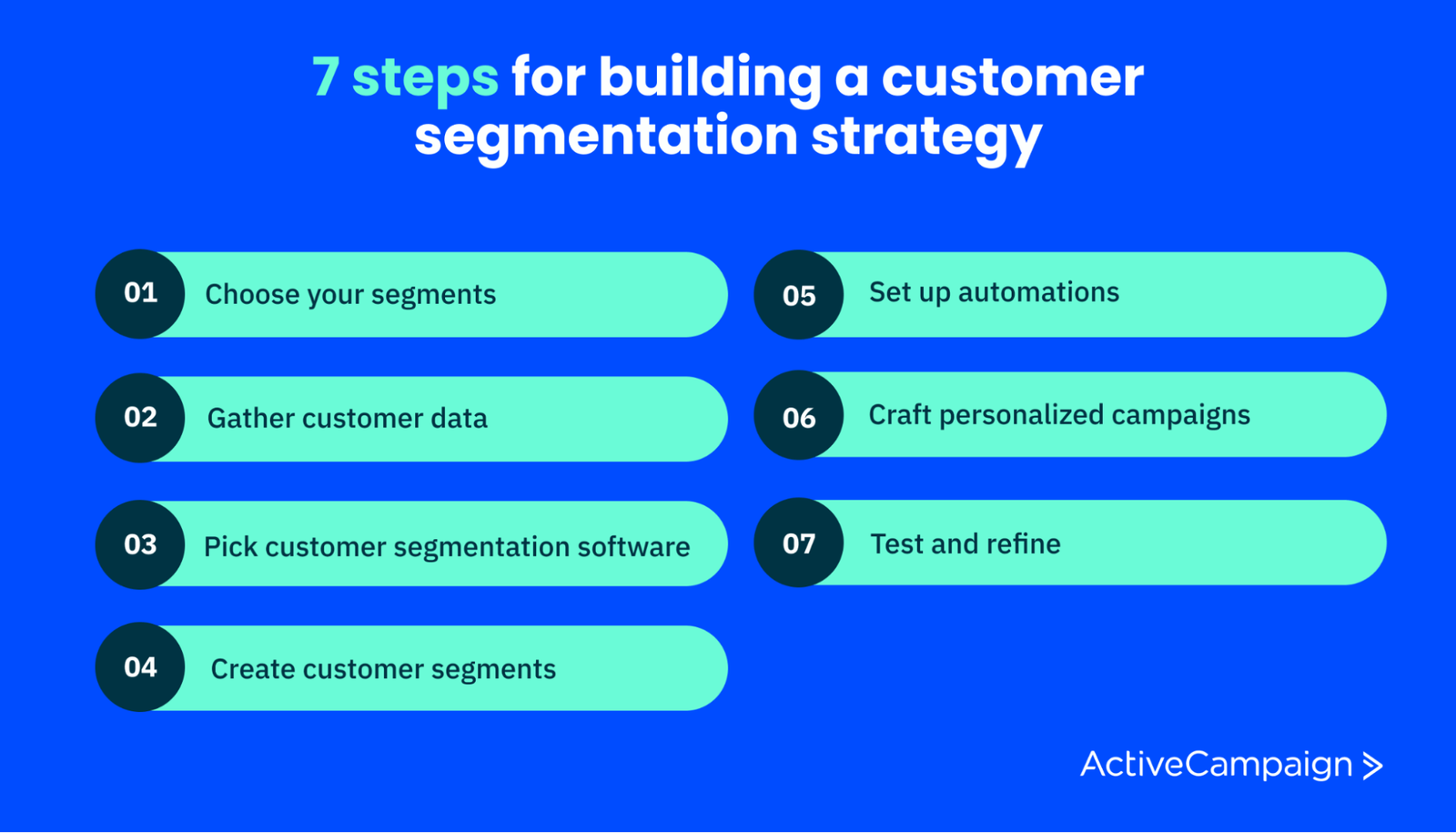
1. Choose your segments
First, what audience segments do you want to use in your strategy? Use the above list to decide what segments will be most helpful based on your business goals. Be sure to consider the needs of your marketing, sales, and customer service teams, as well as any product developers or other interested parties.
If this is your first time doing customer segmentation, start small. Choose a couple of ways to segment your audience and build from that as you begin to see results.
2. Gather customer data
You may store tons of customer data in your CRM, email marketing software, or other data and analytics tools.
Based on your chosen audience segments, start pulling the data you need and organizing it in a helpful way. If the data you need isn't readily available, it's time to dig in and start pulling reports or setting up tools that track and gather customer data.
However, make sure that the data you pull is high quality. You don't want to spend weeks or months working on a campaign based on your customer data only to find out later that the data is inaccurate.
3. Pick customer segmentation software
We'll be honest with you, you'll probably need some customer segmentation software to pull off your strategy. The U.S. marketing analytics market is projected to reach $5.25 billion in 2025, growing at an average annual rate of over 12.73% to reach $9.56 billion by 2030. Many marketing software providers, such as ActiveCampaign, offer segmentation features, and you may be able to find them in the CRM you already use, too.
If you don't have software with list or audience segmentation capabilities, look for one that is easy to use, adaptable to your team's needs, and scalable as your business grows.
You may also want to consider a software solution with AI components. As of 2024, 88% of marketers use AI in their day-to-day roles, with 69% having integrated AI into their marketing operations. This is up from 46% in 2020 and 26% in 2019.
In the example below, you can see how ActiveCampaign can automatically segment customers for you based on customer behavior.

4. Create customer segments
Next, define each customer segment and set them up as tags in your software. Use simple labels for each segment and make sure your entire team knows how to use them. If you can, color-code your segments to get an easy visual of your entire audience.
You might consider creating a key or guide to your customer segments to help your team understand the purpose of each segment or group. It's also smart to limit the number of people who can modify customer segments to preserve the integrity of your marketing data.
5. Set up automations
Automating your customer segmentation will save you a ton of time. Plus, you'll be more accurate. You'll create parameters for each audience segment with customer segmentation and marketing automation. When a customer meets the criteria for a segment, they will be immediately added to the right tags, lists, or groups.
This real-time behavioral segmentation is incredibly helpful, especially for e-commerce professionals, which is why a whopping 77% of marketing ROI comes from segmented, targeted, and triggered campaigns, highlighting the effectiveness of behavioral segmentation in e-commerce.
Some software options, such as ActiveCampaign, offer other automation and personalization features to further your segmentation strategy.
In the example below, a simple action, such as attending a webinar, triggers an automated email to follow up with that contact at the right cadence.
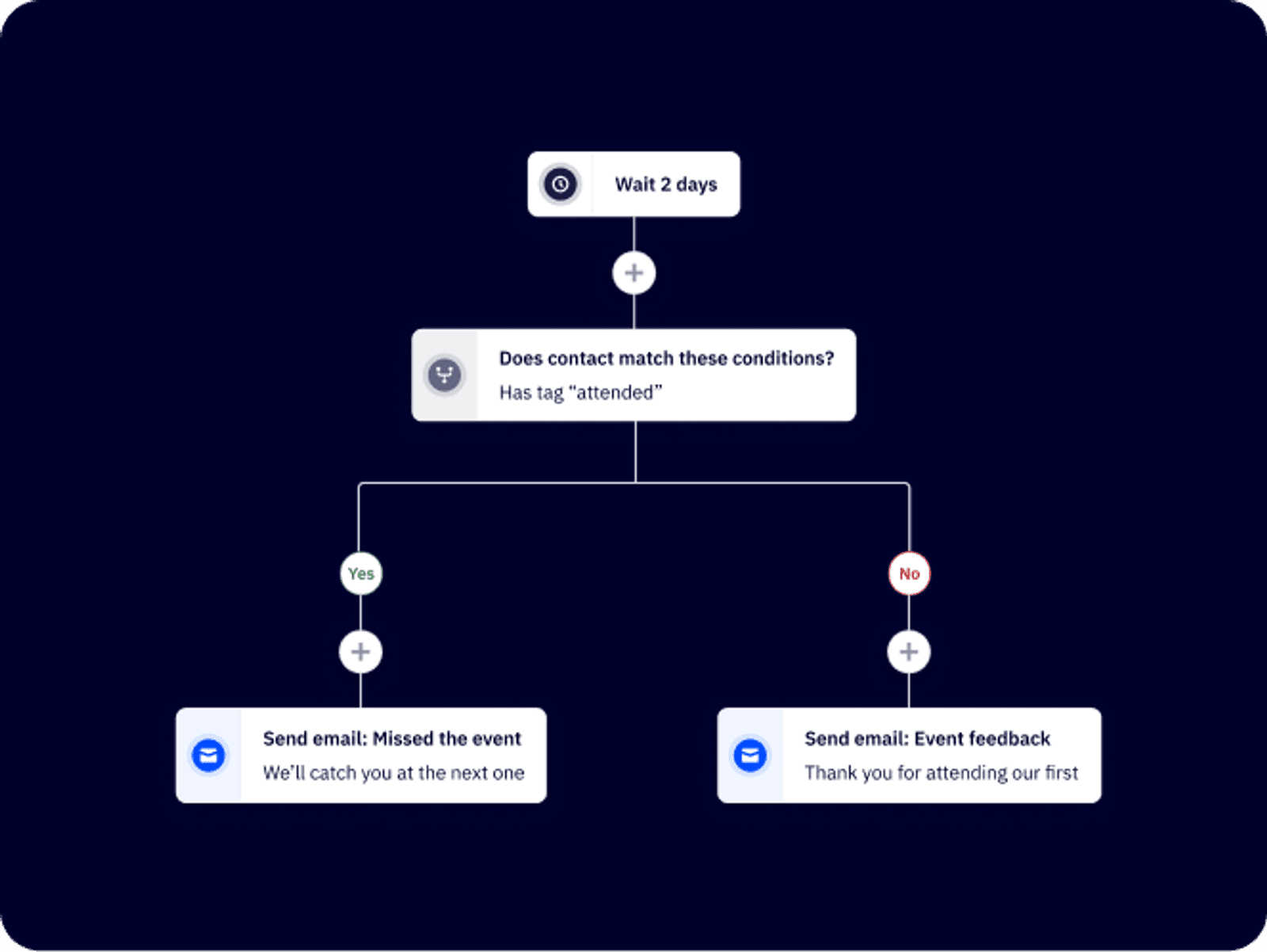
6. Craft personalized campaigns
Now you're ready to put your segments to the test. Send segment-based emails, run targeted local ads, and brainstorm new products based on the segments you've created or discovered in your strategic planning process.
Look out for ways to use your customer data even more effectively. For example, ActiveCampaign also has features like dynamic content, which allows you to automatically pull customer data into a personalized email template.
7. Test and refine your customer segmentation strategy
As with most business strategies, your customer segments may not be perfect the first time. You may be targeting the wrong ones for your marketing goals or not using them as effectively as you could be.
Use the data you collect on customer satisfaction and ROI to test and refine your strategy as you go, ensuring you always get the best results. Pay attention to how your most important marketing metrics change when you add or adjust your customer segments.
For instance, if you start segmenting customers by their interest in a particular product, you'll want to measure the change in sales for that product. An increase likely means your segmentation strategy is working, while a decline in sales might indicate you need to go back to the drawing board and think of new ways to interact with your customers.
4 reasons why customer segmentation is important
Let's take a closer look at four possible positive outcomes from a target segmentation strategy.
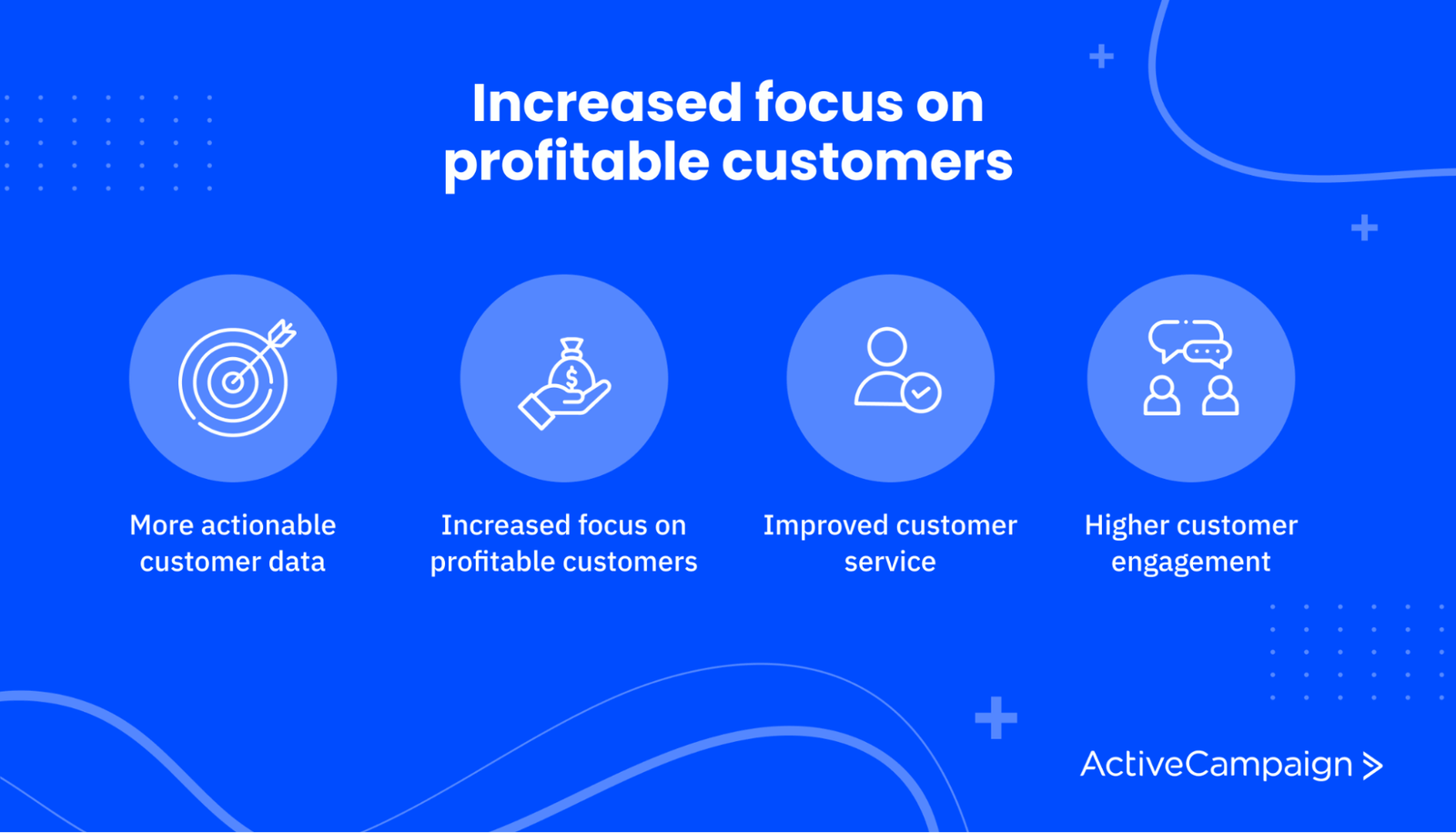
1. Customer segmentation gives you more actionable data
A good customer segmentation strategy identifies common characteristics between your customers. This starts with using data sources that give you the information you need to organize your customer segments.
With this kind of data, you can launch different initiatives for your target audience, including personalized marketing campaigns, which 78% of marketers say they use and 42% of consumers say is important to see.
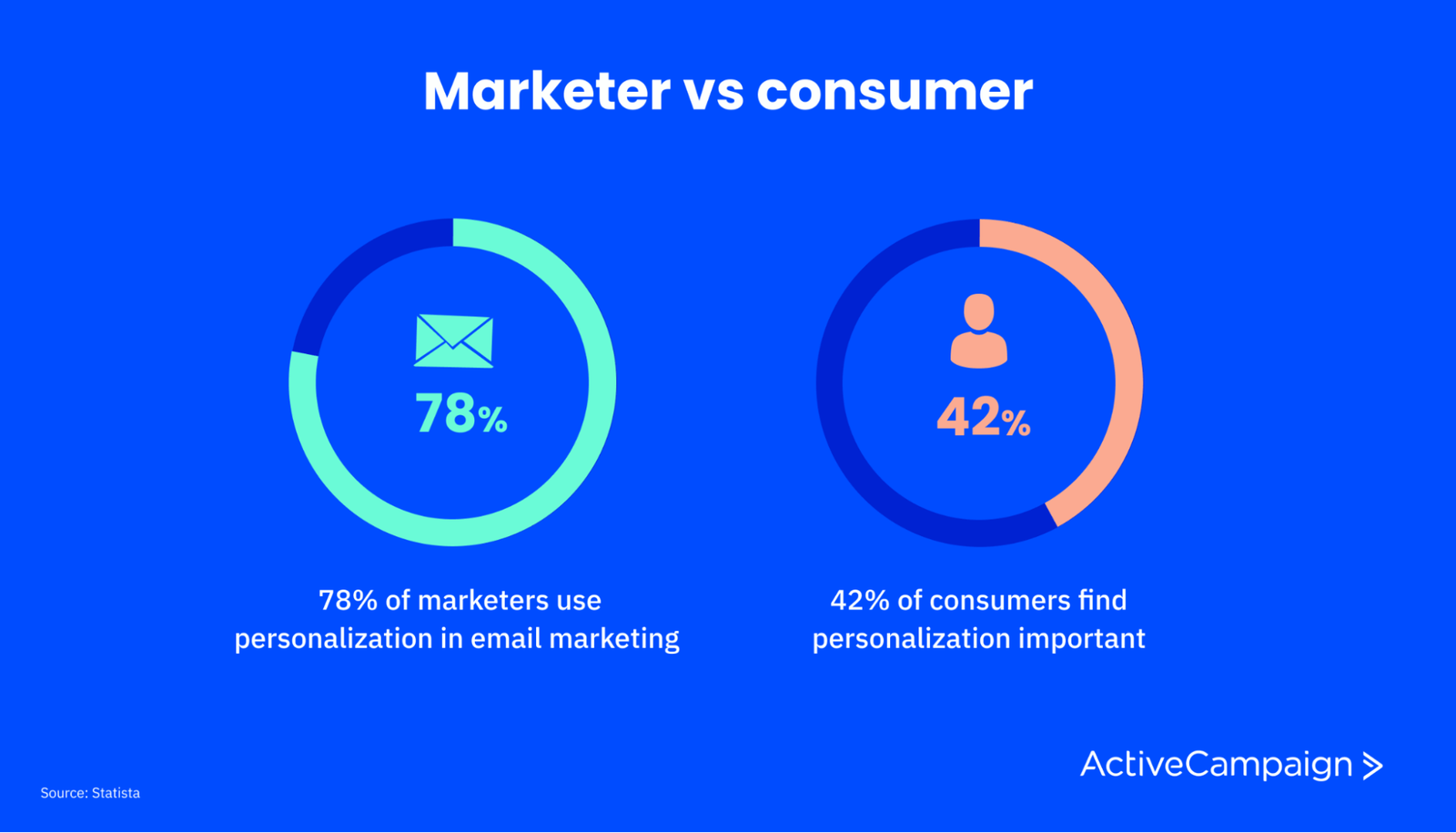
Keep in mind, though, that plenty of personalization strategies aren't obvious to consumers. Tactics like including a customer's first name in your marketing emails are surface-level personalizations your customer data can reveal, but there are plenty of more effective approaches you can pursue.
For example, your customer data may reveal which products your customers are most interested in or have concerns about, aspects like price points or additional features. Use this data to create customer segments and build email marketing campaigns that address each segment's specific concerns.
2. Customer segmentation helps you focus on your most profitable customers
In a customer segmentation strategy, you organize your customers by common characteristics, such as location, age, or income. You'll quickly build a view of your most profitable or high-value customers by segmenting them and gathering data on their buying habits.
The most profitable customers will look different from business to business. They might be high-income buyers after your priciest product or lifelong subscribers whose payments you can count on for years.
Whatever the most profitable looks like for your business, create a segment for it. Then, you can devote extra resources and attention to those customers to close more high-value sales.
3. Customer segmentation enables more personalized customer service
With customer segmentation, you can identify niche pain points and address them in every facet of your business, from pre-purchase to customer service.
For instance, if you have a large segment of customers over 65, consider highlighting your phone support options for this demographic. But Millennials and Gen Z might be more likely to engage with live chat software or self-serve content.
4. Customer segmentation drives higher engagement and loyalty
When you tap into your customers' precise pain points, they're more likely to engage with your brand. And if you can keep that up, they'll come back again.
Of course, when customers are happy, engaged, and loyal, that means great things for your bottom line. Plus, your team will work more efficiently as they focus on tasks that make the most significant impact.
What’s next? How to measure ROI and prove segmentation value
Once you’ve built your customer segments and launched targeted campaigns, the next critical step is showing the impact. Measuring the return on investment (ROI) of segmentation proves its value to your business and helps secure future resources for more personalized marketing efforts.
Here’s how to measure segmentation success effectively.
Track key post-segmentation metrics
Start by monitoring the right metrics that reflect improvements driven by segmentation:
- Conversion rates: Compare conversion rates for segmented audiences versus your general audience.
- Engagement rates: Track open rates, click-through rates, and interaction times across segments.
- Customer lifetime value (CLV): See if personalized journeys are leading to higher repeat purchases and customer loyalty.
- Churn rates: Measure whether retention improves in segments receiving personalized outreach.
- Average order value (AOV): Monitor whether targeted campaigns drive larger purchases among segmented groups.
Set up control groups for accurate comparisons
To truly understand the impact of segmentation, don’t roll out campaigns all at once. Instead, create a control group that continues to receive your standard (non-segmented) marketing, while your segmented audiences experience the new targeted messaging. Over a set period, compare the performance between the segmented and control groups.
This experimental design gives you a clean, apples-to-apples view of how much segmentation is improving key KPIs, ensuring that any lift you see can be confidently attributed to your efforts.
Calculate the financial return on segmentation
To show true ROI:
- Calculate incremental revenue generated by segmented campaigns vs. control groups.
- Subtract the costs associated with segmentation (time, tools, creative).
- Use the formula: (Net Profit / Investment) x 100
A positive ROI percentage demonstrates that segmentation is not just a nice-to-have—it’s a revenue driver.
Present results clearly to stakeholders
When sharing segmentation results with executives or cross-functional teams:
- Focus on business outcomes, like revenue growth, improved CLV, or reduced churn.
- Use simple visuals (charts, tables) to highlight key performance improvements.
- Connect your results back to strategic goals (customer loyalty, faster sales cycles, higher engagement).
- Recommend next steps for scaling segmentation efforts even further.
The clearer you make the connection between segmentation and business success, the easier it will be to earn buy-in for future campaigns and investments.
Unlock personalized growth with ActiveCampaign’s intelligent customer segmentation
Customer segmentation helps you build smarter, more effective marketing strategies by turning raw data into actionable insight. It’s how businesses of all sizes personalize experiences, improve targeting, and ultimately drive better results—without increasing workload.
With ActiveCampaign, segmentation is more than just grouping contacts. It’s a complete system for dynamic audience targeting, personalized automation, and ROI-focused campaign optimization. You can create behavior-based segments, deliver tailored content automatically, and measure the results, so every marketing decision feels more strategic.
“With the marketing dashboard in ActiveCampaign, the data is right in front of me. I can see exactly how much I’m earning from each email and automation… that’s been about 30% of my automation revenue over the past year.” ~Your Therapy Source
Ready to see how segmentation can transform your marketing?
Start your free trial or talk to an expert today to explore how ActiveCampaign’s intelligent segmentation tools can help you convert more leads, grow customer loyalty, and unlock your next phase of personalized growth.
Customer segmentation frequently asked questions
Have more questions about customer segmentation? Here are a few quick answers to help you get started.
What is a customer segment?
A customer segment is a group of people within your audience who share similar characteristics, such as behaviors, interests, demographics, or purchase history. Instead of sending the same message to everyone, segmentation helps you tailor your communication to each group, making it more relevant and effective. Think of it as grouping customers by what matters most to them, so your marketing can speak directly to their needs.
Can small businesses benefit from customer segmentation?
Yes, arguably more than anyone. When you have limited time, budget, or resources, segmentation helps you focus your efforts where they matter most. Instead of casting a wide net, small teams can use segmentation to identify high-intent audiences, personalize messages without extra lift, and boost ROI without burning out.
The right tools make it easy to segment based on behavior, engagement, or lifecycle stage—no advanced data team required.
When and why is AI used for segmenting customers?
AI enhances segmentation by making it smarter, faster, and more scalable. Instead of manually sorting customers into groups, AI can analyze behavior patterns and trends in real time, uncovering insights you might miss. It can also automate updates to your segments as customers take new actions, like clicking a link or abandoning a cart, so your messaging is always relevant.
Ultimately, AI makes it easier to deliver the right message to the right person at the right time.

